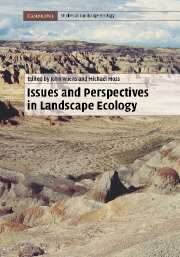Book contents
- Frontmatter
- Contents
- List of contributors
- Preface
- PART I Introductory perspectives
- PART II Theory, experiments, and models in landscape ecology
- PART III Landscape patterns
- PART IV Landscape dynamics on multiple scales
- PART V Applications of landscape ecology
- 18 Landscape ecology as the broker between information supply and management application
- 19 Farmlands for farming and nature
- 20 Landscape ecology and forest management
- 21 Landscape ecology and wildlife management
- 22 Restoration ecology and landscape ecology
- 23 Conservation planning at the landscape scale
- 24 Landscape conservation: a new paradigm for the conservation of biodiversity
- 25 The “why?” and the “so what?” of riverine landscapes
- PART VI Cultural perspectives and landscape planning
- PART VII Retrospect and prospect
- Index
- Plate section
- References
18 - Landscape ecology as the broker between information supply and management application
from PART V - Applications of landscape ecology
Published online by Cambridge University Press: 20 November 2009
- Frontmatter
- Contents
- List of contributors
- Preface
- PART I Introductory perspectives
- PART II Theory, experiments, and models in landscape ecology
- PART III Landscape patterns
- PART IV Landscape dynamics on multiple scales
- PART V Applications of landscape ecology
- 18 Landscape ecology as the broker between information supply and management application
- 19 Farmlands for farming and nature
- 20 Landscape ecology and forest management
- 21 Landscape ecology and wildlife management
- 22 Restoration ecology and landscape ecology
- 23 Conservation planning at the landscape scale
- 24 Landscape conservation: a new paradigm for the conservation of biodiversity
- 25 The “why?” and the “so what?” of riverine landscapes
- PART VI Cultural perspectives and landscape planning
- PART VII Retrospect and prospect
- Index
- Plate section
- References
Summary
In this era of very sophisticated and still-developing GIS functionality, and with an as-yet unknown availability of data, some argue that we do not need integrated ecological (land) classification and mapping nor (ecosystem) geographers. In fact, they maintain, we do not need landscape ecology at all, as the knowledge gathered by all the underlying more specialist disciplines makes it a superfluous discipline: the information technicians can easily handle, combine, and provide all the required information, and the policy makers can select the relevant information and draw conclusions by themselves.
Here we have, in my opinion, two mistakes. One is that integrated classification and mapping is old-fashioned and can be done without, and the second is that transdisciplines are superfluous in this era of information technology. I will explain why I consider these to be mistakes. Meanwhile, I will argue that we need landscape ecology as a mind-set or attitude for professionals in spatial planning and in policy analysis even more urgently than as a scientific discipline in its own right. I will refer to recent experiences from my current involvement in river (basin) management. Finally, I will go into some issues that, in my opinion, will require the attention of landscape ecologists in the near future, but without having the necessity of incorporating them into “our discipline”.
The stage
Some years ago I wrote that ecological land classification is a quintessential tool to be used in two fields: for land evaluation for land-use planning, and for environmental impact assessment (EIA) in the planning of such activities as infrastructure planning, water resource exploitation, or river management (Klijn, 1997).
- Type
- Chapter
- Information
- Issues and Perspectives in Landscape Ecology , pp. 181 - 192Publisher: Cambridge University PressPrint publication year: 2005
References
- 1
- Cited by



